Paper Menu >>
Journal Menu >>
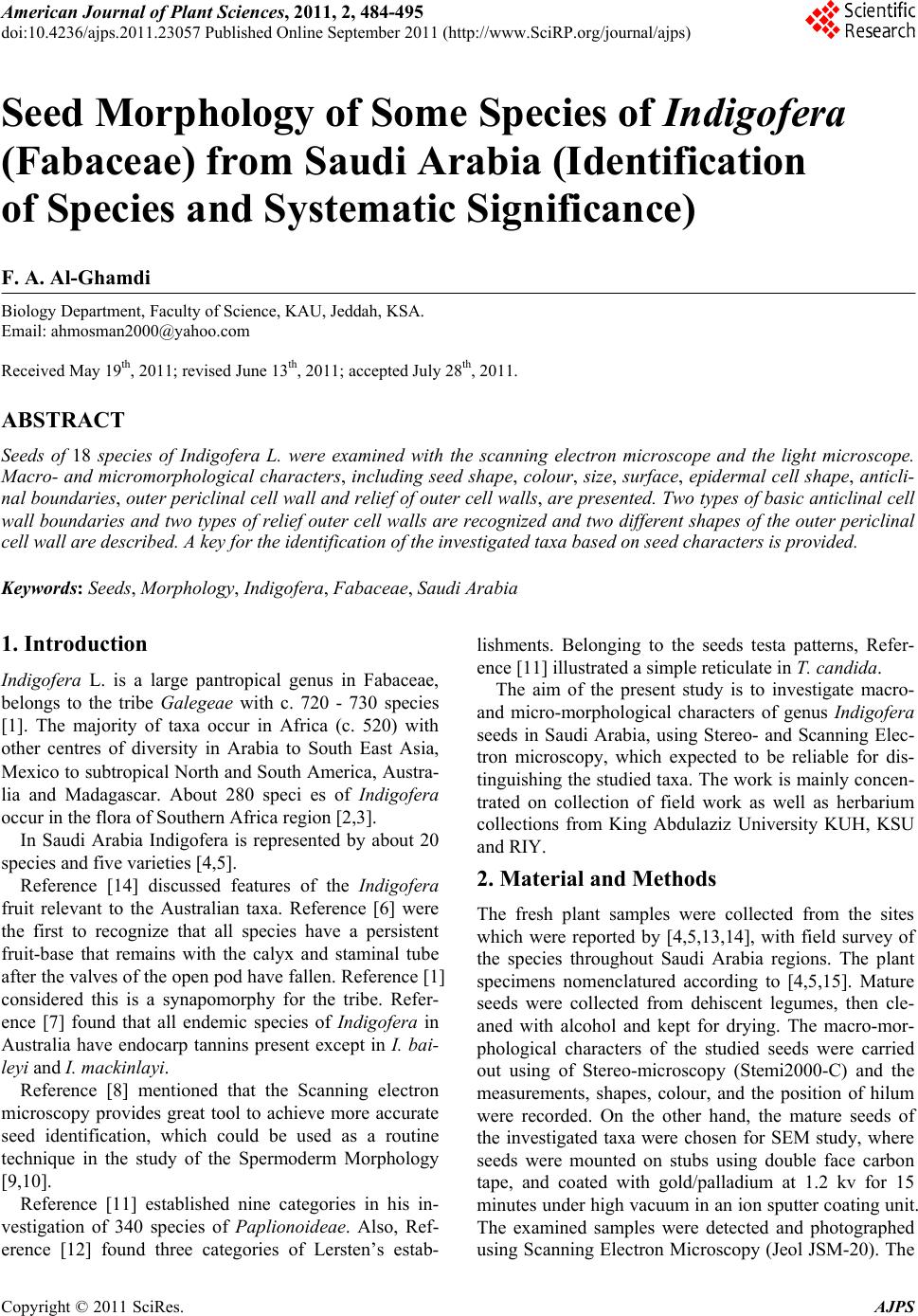 American Journal of Plant Sciences, 2011, 2, 484-495 doi:10.4236/ajps.2011.23057 Published Online September 2011 (http://www.SciRP.org/journal/ajps) Copyright © 2011 SciRes. AJPS Seed Morphology of Some Species of Indigofera (Fabaceae) from Saudi Arabia (Identification of Species and Systematic Significance) F. A. Al-Ghamdi Biology Department, Faculty of Science, KAU, Jeddah, KSA. Email: ahmosman2000@yahoo.com Received May 19th, 2011; revised June 13th, 2011; accepted July 28th, 2011. ABSTRACT Seeds of 18 species of Indigofera L. were examined with the scanning electron microscope and the light microscope. Macro- and micromorphological characters, including seed shape, colour, size, surface, epidermal cell shape, anticli- nal boundaries, outer periclinal cell wall and relief of outer cell walls, are presented. Two types of basic anticlinal cell wall boundaries and two typ es of relief outer cell walls are recognized and two different shap es of the outer periclinal cell wall are described. A key for the iden tification of the investigated taxa based on seed chara c ters is provided. Keywords: Seeds, Morpholog y , Indigofera, Fabace ae, Saudi Arabia 1. Introduction Indigofera L. is a large pantropical genus in Fabaceae, belongs to the tribe Galegeae with c. 720 - 730 species [1]. The majority of taxa occur in Africa (c. 520) with other centres of diversity in Arabia to South East Asia, Mexico to subtropical North and South America, Austra- lia and Madagascar. About 280 speci es of Indigofera occur in the flora of Southern Africa region [2,3]. In Saudi Arabia Indigofera is represented by about 20 species and five varieties [4,5]. Reference [14] discussed features of the Indigofera fruit relevant to the Australian taxa. Reference [6] were the first to recognize that all species have a persistent fruit-base that remains with the calyx and staminal tube after the valves of the open pod have fallen. Reference [1] considered this is a synapomorphy for the tribe. Refer- ence [7] found that all endemic species of Indigofera in Australia have endocarp tannins present except in I. bai- leyi and I. mackinlayi. Reference [8] mentioned that the Scanning electron microscopy provides great tool to achieve more accurate seed identification, which could be used as a routine technique in the study of the Spermoderm Morphology [9,10]. Reference [11] established nine categories in his in- vestigation of 340 species of Paplionoideae. Also, Ref- erence [12] found three categories of Lersten’s estab- lishments. Belonging to the seeds testa patterns, Refer- ence [11] illustrated a simple reticulate in T. candida. The aim of the present study is to investigate macro- and micro-morphological characters of genus Indigofera seeds in Saudi Arabia, using Stereo- and Scanning Elec- tron microscopy, which expected to be reliable for dis- tinguishing the studied taxa. The work is mainly concen- trated on collection of field work as well as herbarium collections from King Abdulaziz University KUH, KSU and RIY. 2. Material and Methods The fresh plant samples were collected from the sites which were reported by [4,5,13,14], with field survey of the species throughout Saudi Arabia regions. The plant specimens nomenclatured according to [4,5,15]. Mature seeds were collected from dehiscent legumes, then cle- aned with alcohol and kept for drying. The macro-mor- phological characters of the studied seeds were carried out using of Stereo-microscopy (Stemi2000-C) and the measurements, shapes, colour, and the position of hilum were recorded. On the other hand, the mature seeds of the investigated taxa were chosen for SEM study, where seeds were mounted on stubs using double face carbon tape, and coated with gold/palladium at 1.2 kv for 15 minutes under high vacuum in an ion sputter coating unit. The examined samples were detected and photographed using Scanning Electron Microscopy (Jeol JSM-20). The 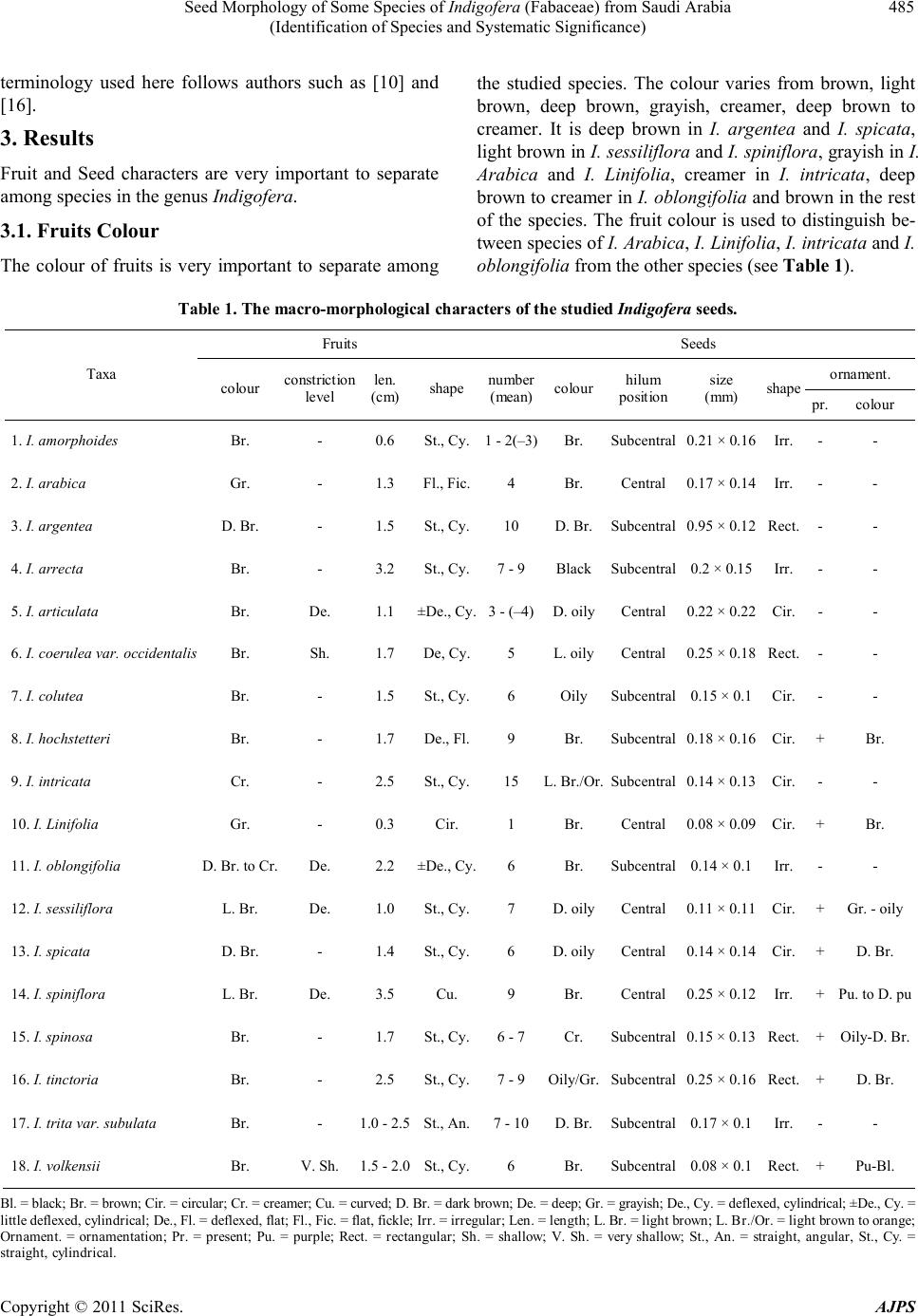 Seed Morphology of Some Species of Indigofera (Fabaceae) from Saudi Arabia 485 (Identification of Species and Systematic Significance) terminology used here follows authors such as [10] and [16]. 3. Results Fruit and Seed characters are very important to separate among species in the genus Indigofera. 3.1. Fruits Colour The colour of fruits is very important to separate among the studied species. The colour varies from brown, light brown, deep brown, grayish, creamer, deep brown to creamer. It is deep brown in I. argentea and I. spicata, light brown in I. sessiliflora and I. spiniflo ra, grayish in I. Arabica and I. Linifolia, creamer in I. intricata, deep brown to creamer in I. oblongifolia and brown in the rest of the species. The fruit colour is used to distinguish be- tween species of I. Arabica, I. Linifolia, I. intricata and I. oblongifolia from the other species (see Table 1). Table 1. The macro-morphological characters of the studied Indigofera s ee ds. Fruits Seeds ornament. Taxa colour constriction level len. (cm)shape numb e r (mean)colour hilum position size (mm) shape pr.colour 1. I. amorphoides Br. - 0.6 St., Cy.1 - 2(–3)Br. Subcentral0.21 × 0.16 Irr. - - 2. I. arabica Gr. - 1.3 Fl., Fic.4 Br. Central 0.17 × 0.14 Irr. - - 3. I. argentea D. Br. - 1.5 St., Cy.10 D. Br.Subcentral0.95 × 0.12 Rect. - - 4. I. arrecta Br. - 3.2 St., Cy.7 - 9 BlackSubcentral0.2 × 0. 15 Irr. - - 5. I. articulata Br. De. 1.1 ±De., Cy.3 - (–4)D. oilyCentral 0.22 × 0.22 Cir. - - 6. I. coerulea var. occidentalis Br. Sh. 1.7 De, Cy.5 L. oilyCentral 0.25 × 0.18 Rect. - - 7. I. colutea Br. - 1.5 St., Cy.6 Oily Subcentral0.15 × 0. 1 Cir. - - 8. I. hochstetteri Br. - 1.7 De., Fl.9 Br. Su b c entral0.18 × 0.16 Cir. + Br. 9. I. intricata Cr. - 2.5 St., Cy.15 L. Br ./Or.Subcentral0.14 × 0.13 Cir. - - 10. I. Linifolia Gr. - 0.3 Cir. 1 Br. Central 0.08 × 0.09 Cir. + Br. 11. I. oblongifol i a D. Br. to Cr. De. 2.2 ±De., Cy.6 Br. Subcentral0.14 × 0.1 Irr. - - 12. I. sessiliflora L. Br. De. 1.0 St., Cy.7 D. oilyCentral 0.11 × 0.11 Cir. + Gr. - oily 13. I. spicata D. Br. - 1.4 St., Cy.6 D. oilyCentral 0.14 × 0.14 Cir. + D. Br. 14. I. spiniflora L. Br. De. 3.5 Cu. 9 Br. Central 0.25 × 0.12 Irr. + Pu. to D. pu 15. I. spinosa Br. - 1.7 St., Cy.6 - 7 Cr. Subcentral0.15 × 0.13 Rect. + Oily-D. Br. 16. I. tinctoria Br. - 2.5 St., Cy.7 - 9 Oily/Gr.Subcentral0.25 × 0.16 Rect. + D. Br. 17. I. trita var. subulata Br. - 1. 0 - 2.5St., An.7 - 10D. Br.Subcentral0. 17 × 0.1 Irr. - - 18. I. volkensii Br. V. Sh. 1.5 - 2.0St., Cy.6 Br. Subcentral0.08 × 0 .1 Rect. + P u-Bl. Bl. = black; Br. = brown; Cir. = circular; Cr. = creamer; Cu. = curved; D. Br. = dark brown; De. = deep; Gr. = grayish; De., Cy. = deflexed, cylindrical; ±De., Cy. = little de f le xed, cylindrical; De., Fl. = deflexed, flat; Fl., Fic. = flat, fickle; Irr. = irregular; Len . = length; L. Br. = light br own; L. Br./Or. = light brown to orange; Ornament. = ornamentation; Pr. = present; Pu. = purple; Rect. = rectangular; Sh. = shallow; V. Sh. = very shallow; St., An. = straight, angular, St., Cy. = straight, c y li ndr ical . Copyright © 2011 SciRes. AJPS 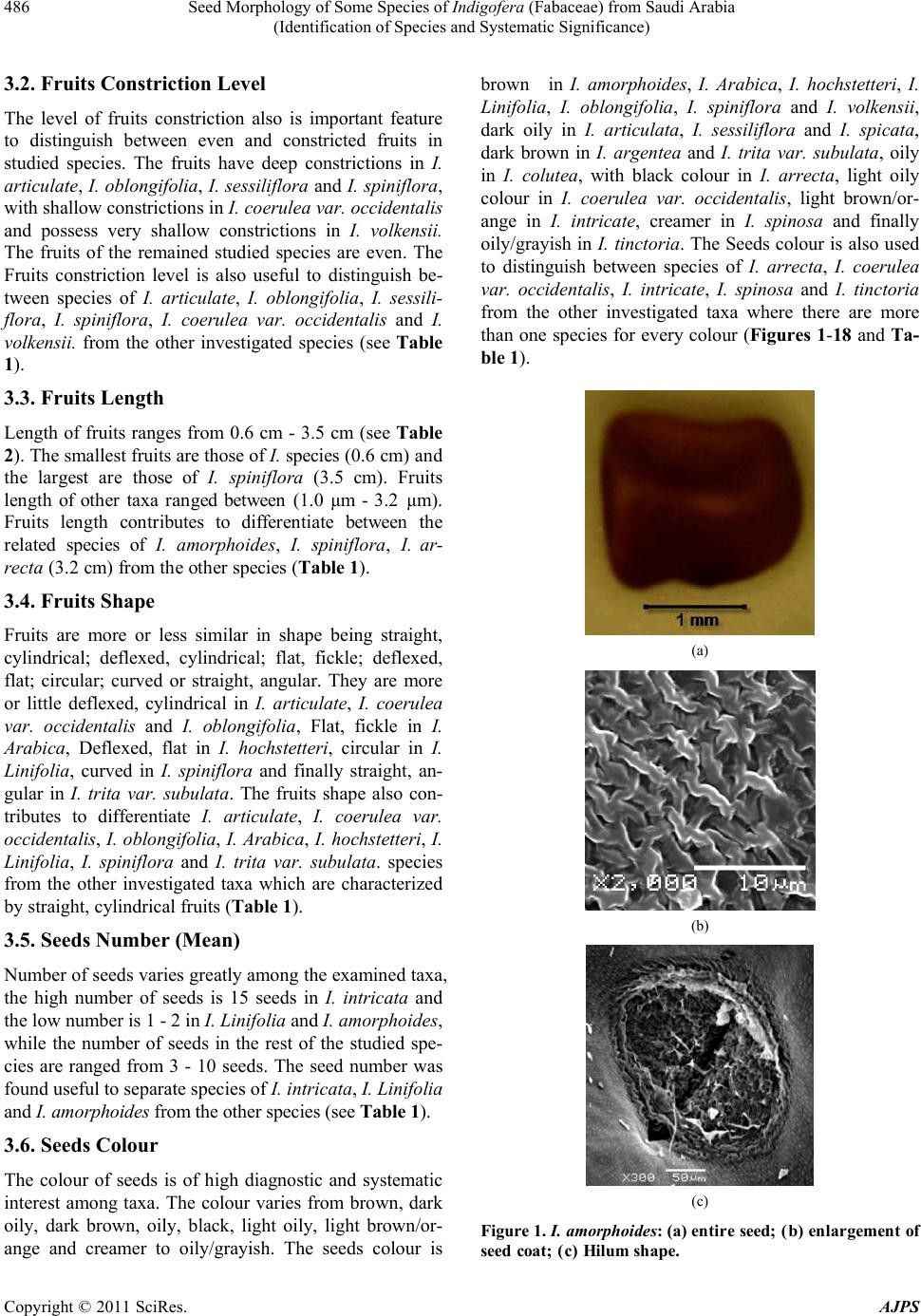 Seed Morphology of Some Species of Indigofera (Fabaceae) from Saudi Arabia 486 (Identification of Species and Systematic Significance) 3.2. Fruits Constriction Level The level of fruits constriction also is important feature to distinguish between even and constricted fruits in studied species. The fruits have deep constrictions in I. articulate, I. oblon gifolia, I. sessiliflora and I. spiniflora , with shallow cons trictions in I. coerulea var. occidentalis and possess very shallow constrictions in I. volkensii. The fruits of the remained studied species are even. The Fruits constriction level is also useful to distinguish be- tween species of I. articulate, I. oblongifolia, I. sessili- flora, I. spiniflora, I. coerulea var. occidentalis and I. volkensii. from the other investigated species (see Table 1). 3.3. Fruits Length Length of fruits ranges from 0.6 cm - 3.5 cm (see Table 2). The smallest fruits are those of I. sp eci es (0 . 6 cm) a nd the largest are those of I. spiniflora (3.5 cm). Fruits length of other taxa ranged between (1.0 µm - 3.2 µm). Fruits length contributes to differentiate between the related species of I. amorphoides, I. spiniflora, I. ar- recta (3 .2 cm ) from the ot her s p eci es ( Table 1). 3.4. Fruits Shape Fruits are more or less similar in shape being straight, cylindrical; deflexed, cylindrical; flat, fickle; deflexed, flat; circular; curved or straight, angular. They are more or little deflexed, cylindrical in I. articulate, I. coerulea var. occidentalis and I. oblongifolia, Flat, fickle in I. Arabica, Deflexed, flat in I. hochstetteri, circular in I. Linifolia, curved in I. spiniflora and finally straight, an- gular in I. trita var. subulata. The fruits shape also con- tributes to differentiate I. articulate, I. coerulea var. occidentalis, I. oblongifolia, I. Arabica, I. hochstetteri, I. Linifolia, I. spiniflora and I. trita var. subulata. species from the other investigated taxa which are characterized by straight, cylindrical fruits (Table 1). 3.5. Seeds Number (Mean) Number of seeds varies greatly among the examined taxa, the high number of seeds is 15 seeds in I. intricata and the low number is 1 - 2 in I. Linifolia and I. amorphoides, while the number of seeds in the rest of the studied spe- cies are ranged from 3 - 10 seeds. The seed number was found useful to separate species of I. intricata, I. Linifolia and I. amorphoides from the other species (see Table 1). 3.6. Seeds Colour The colour of seeds is of high diagnostic and systematic interest among taxa. The colour varies from brown, dark oily, dark brown, oily, black, light oily, light brown/or- ange and creamer to oily/grayish. The seeds colour is brown in I. amorphoides, I. Arabica, I. hochstetteri, I. Linifolia, I. oblongifolia, I. spiniflora and I. volkensii, dark oily in I. articulata, I. sessiliflora and I. spicata, dark brown in I. argentea and I. trita var. subulata, oily in I. colutea, with black colour in I. arrecta, light oily colour in I. coerulea var. occidentalis, light brown/or- ange in I. intricate, creamer in I. spinosa and finally oily/grayish in I. tinctoria. The Seeds colour is also used to distinguish between species of I. arrecta, I. coerulea var. occidentalis, I. intricate, I. spinosa and I. tinctoria from the other investigated taxa where there are more than one species for every colour (Figures 1-18 and Ta- ble 1). (a) (b) (c) Figure 1. I. amorphoides: (a) enti re seed; (b) enl ar gement of seed coat; ( c) H il um shape. Copyright © 2011 SciRes. AJPS 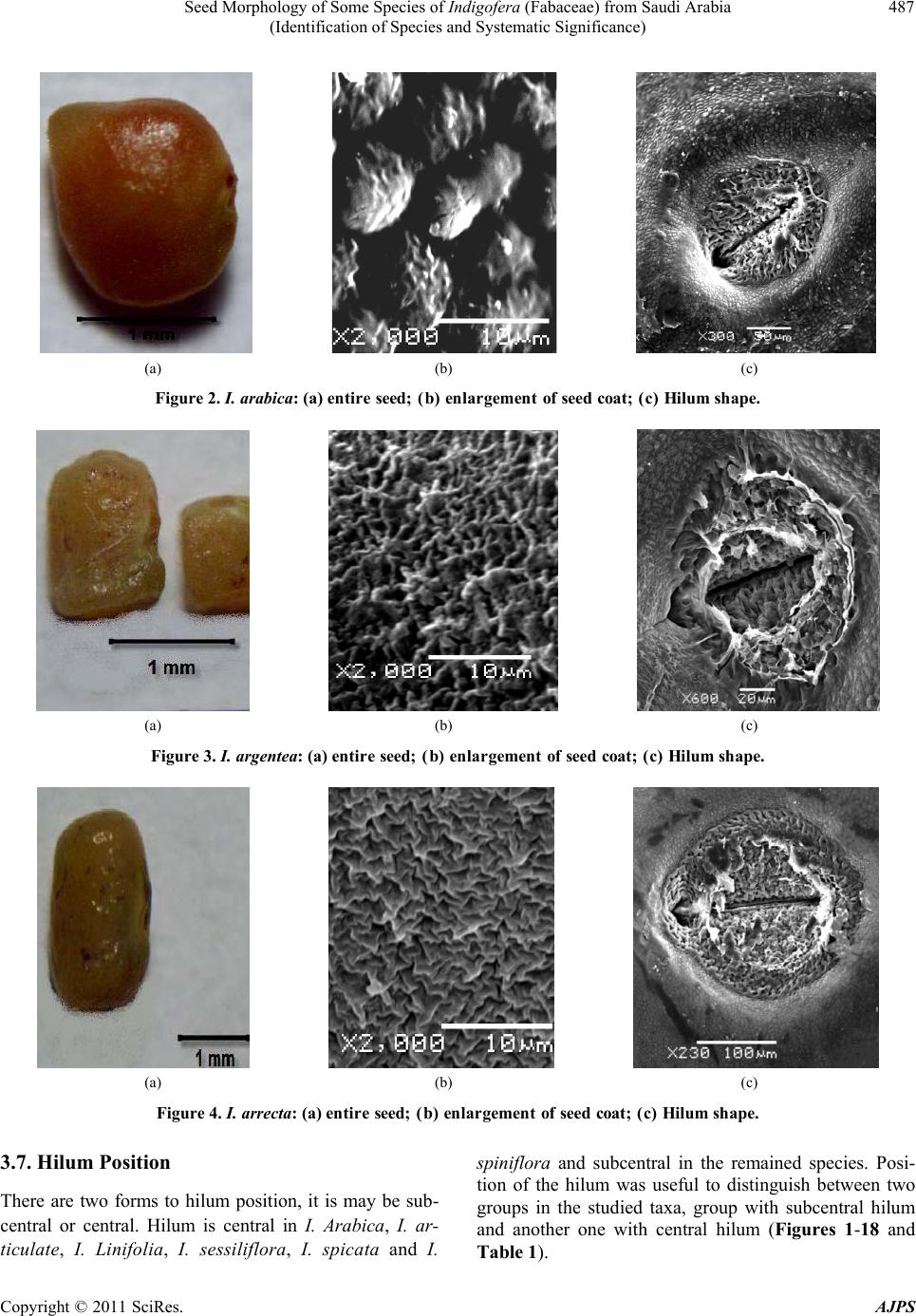 Seed Morphology of Some Species of Indigofera (Fabaceae) from Saudi Arabia 487 (Identification of Species and Systematic Significance) (a) (b) (c) Figure 2. I. arabica: (a) enti re seed; (b) enla rgement of seed coat; ( c ) H il um shape. (a) (b) (c) Figure 3. I. argentea: (a) entir e seed; (b) enl argement of seed coat; (c) H il um shape. (a) (b) (c) Figure 4. I. arrecta: (a) entire seed; (b) enlargement of seed coat; (c ) H il um shape. 3.7. Hilum Position There are two forms to hilum position, it is may be sub- central or central. Hilum is central in I. Arabica, I. ar- ticulate, I. Linifolia, I. sessiliflora, I. spicata and I. spiniflora and subcentral in the remained species. Posi- tion of the hilum was useful to distinguish between two groups in the studied taxa, group with subcentral hilum and another one with central hilum (Figures 1-18 and Table 1). Copyright © 2011 SciRes. AJPS 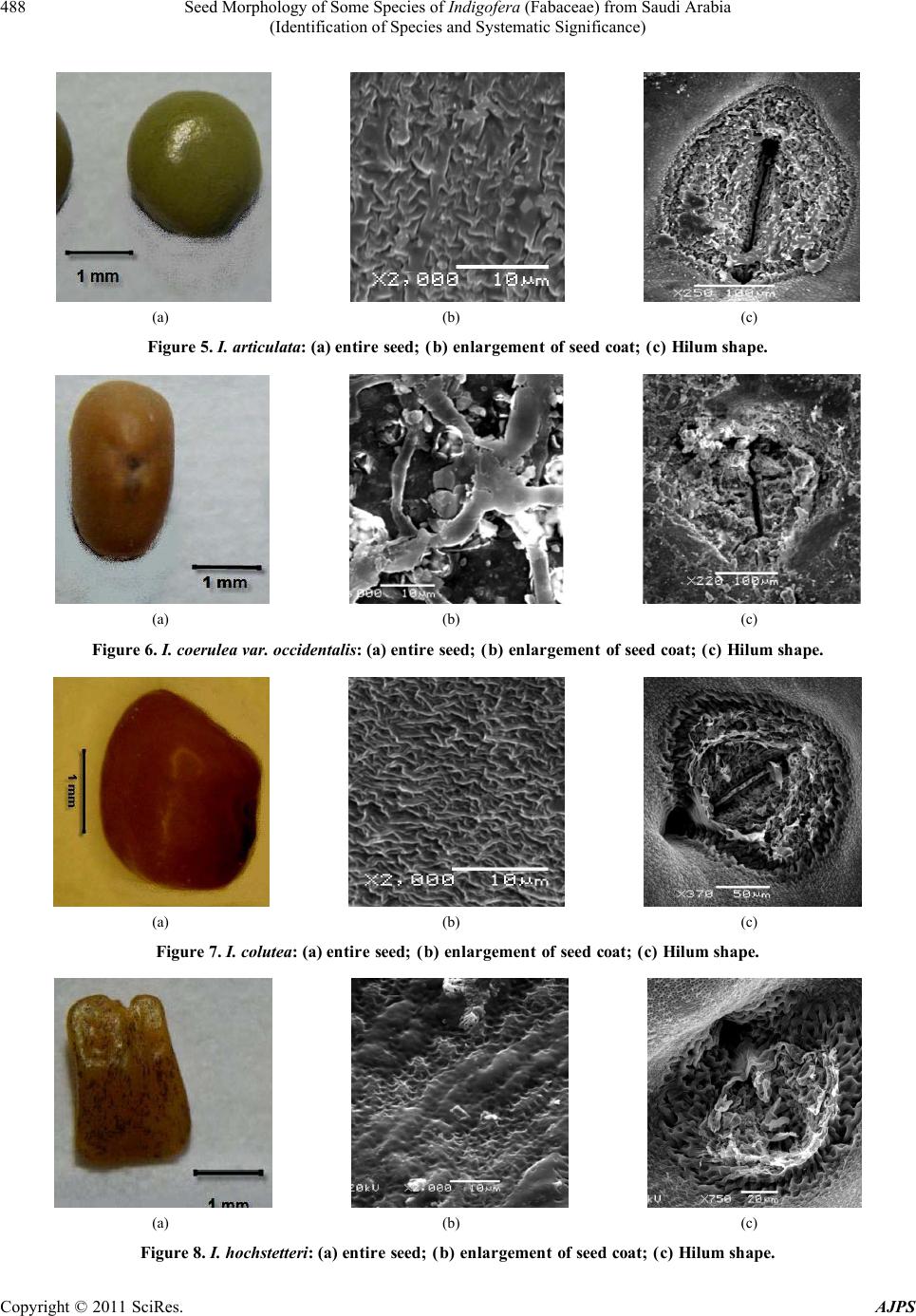 Seed Morphology of Some Species of Indigofera (Fabaceae) from Saudi Arabia 488 (Identification of Species and Systematic Significance) (a) (b) (c) Figure 5. I. articulata: (a) ent ir e seed; (b) enla rgement of seed coat; ( c ) H il um shape. (a) (b) (c) Figure 6. I. coerulea var. occidentalis: (a) entire seed; (b) en largement of seed coat; (c) H il um shape. (a) (b) (c) Figure 7. I. colute a : (a) entire seed; (b) enlargement of seed coat; (c) H il um shape. (a) (b) (c) Figure 8. I. hochstetteri: (a) enti re seed; (b) enlargement of seed coat; (c) H il um shape. Copyright © 2011 SciRes. AJPS  Seed Morphology of Some Species of Indigofera (Fabaceae) from Saudi Arabia 489 (Identification of Species and Systematic Significance) (a) (b) (c) Figure 9. I. intricate: (a) entir e seed; (b) enl argement of seed coat; (c) H il um shape. (a) (b) (c) Figure 10. I. linifolia: (a) entir e seed; (b) enl argement of seed coat; (c) H il um shape. (a) (b) (c) Figure 11. I. oblongifolia: (a) enti re seed; (b) enlargement of seed coat; (c) H il um shape. (a) (b) (c) Figure 12. I. sessiliflora: (a) entire seed; (b) enlargement of seed coat; (c) H il um shape. Copyright © 2011 SciRes. AJPS 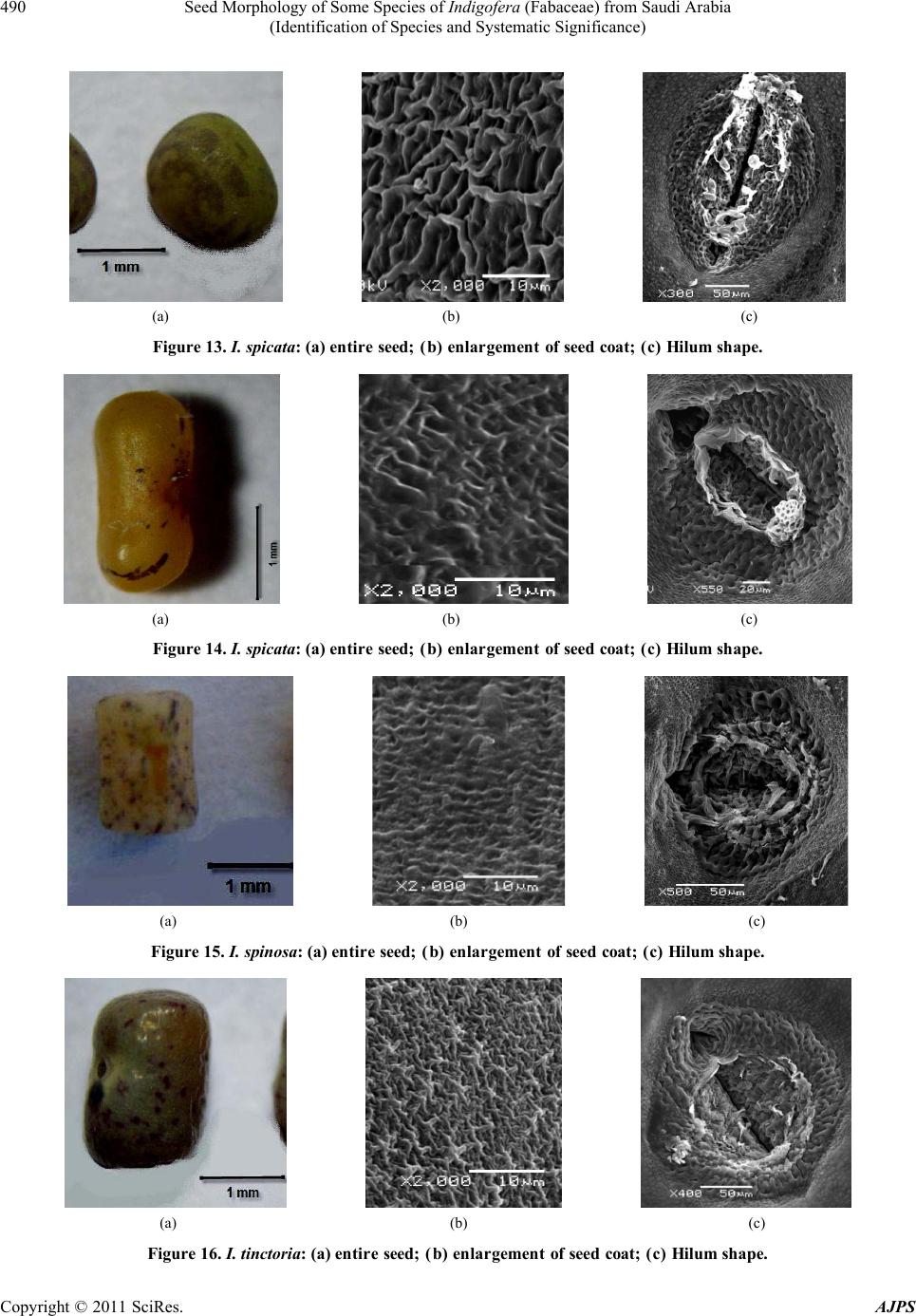 Seed Morphology of Some Species of Indigofera (Fabaceae) from Saudi Arabia 490 (Identification of Species and Systematic Significance) (a) (b) (c) Figure 13. I. spicata: (a) enti re seed; (b) en largement of seed coat; (c) H il um shape. (a) (b) (c) Figure 14. I. spicata: (a) enti re seed; (b) en largement of seed coat; (c) H il um shape. (a) (b) (c) Figure 15. I. spinosa: (a) enti re seed; (b) en largement of seed coat; (c) H il um shape. (a) (b) (c) Figure 16. I. tinc t or i a: (a) entire seed; (b) enlargement of seed coat; (c) H il um shape. Copyright © 2011 SciRes. AJPS 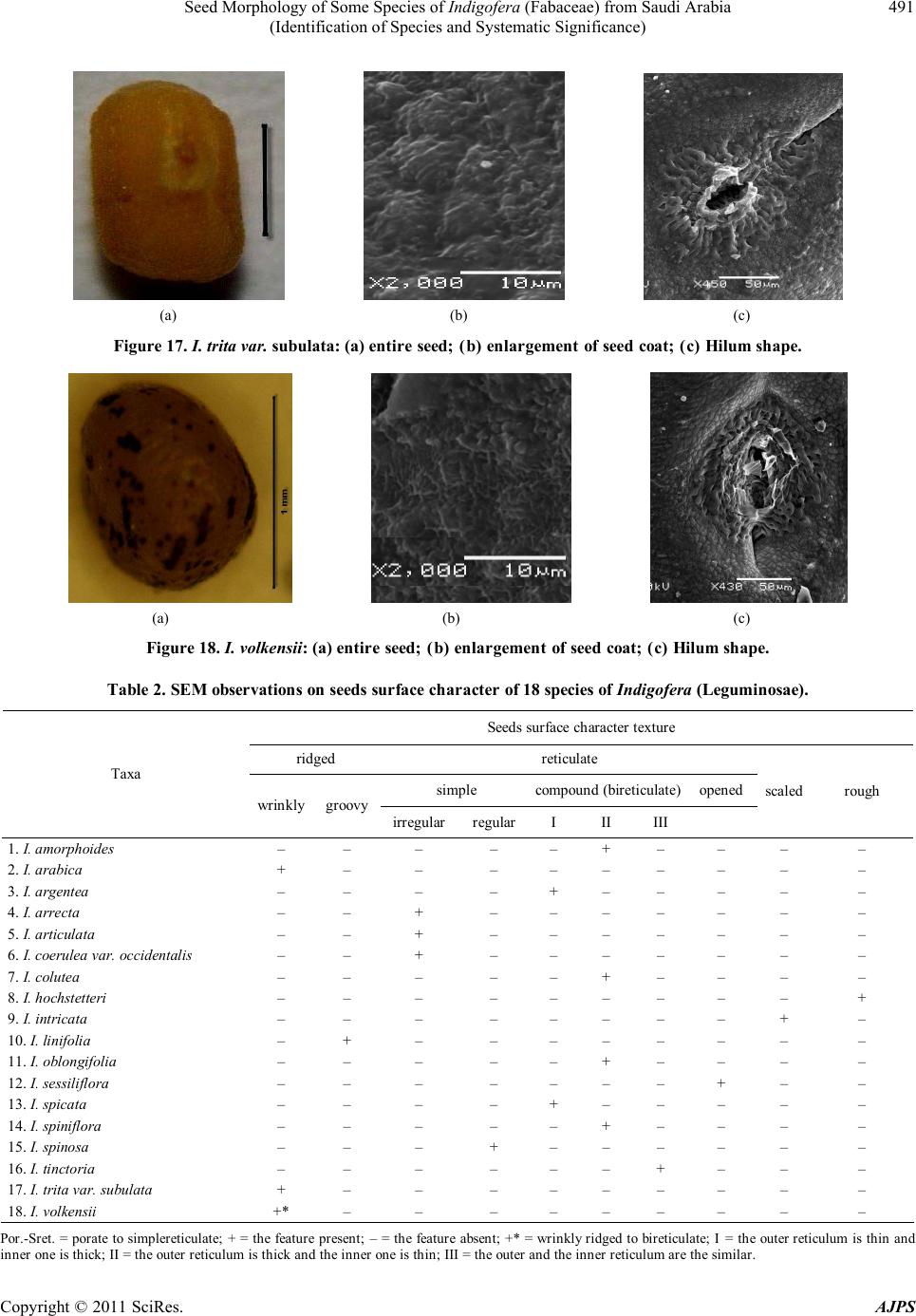 Seed Morphology of Some Species of Indigofera (Fabaceae) from Saudi Arabia 491 (Identification of Species and Systematic Significance) (a) (b) (c) Figure 17. I. trita var. subulata: (a) entire seed; (b) enla rg ement of seed coat; (c) H il um shape. (a) (b) (c) Figure 18. I. volkens ii: (a) entire seed; (b) enlargement of seed coat; (c) H il um shape. Ta bl e 2 . SE M obser va t i on s on seed s surface ch a racter of 18 speci es of Indigofera (L e gum i nos ae ). Seed s s u rface chara cter te xture ridged r etic u late s i mpl e compound (b i r etic ul ate )open e d T a x a wr i nkly groovy i rr e gul a rr e gul a r I II III s cale d rough 1. I. amorpho i des – – – – – + – – – – 2. I. arabi c a + – – – – – – – – – 3. I. a rgen te a – – – – + – – – – – 4. I. arr ect a – – + – – – – – – – 5. I. ar tic u l ata – – + – – – – – – – 6. I. coerul ea var. o cci denta li s – – + – – – – – – – 7. I. c o l ut e a – – – – – + – – – – 8. I. hochs tette r i – – – – – – – – – + 9. I. i n t r ic ata – – – – – – – – + – 10. I. li ni f ol i a – + – – – – – – – – 11. I. ob l ong if o li a – – – – – + – – – – 12. I. s e ss ilifl ora – – – – – – – + – – 13. I. spi c ata – – – – + – – – – – 14. I. spin ifl ora – – – – – + – – – – 15. I. spinosa – – – + – – – – – – 16. I. ti nc t or i a – – – – – – + – – – 17. I. tri ta var. subula t a + – – – – – – – – – 18. I. v o lke ns ii +* – – – – – – – – – Por.-Sret. = porate to simplereticulate; + = the feature present; – = the feature absent; +* = wrin kly ridged to bireticulate; I = the out e r reticulum is th in and inn er one is thick; II = the outer r eticulum is thick and the inner one is thin; III = the outer and th e inner r et ic ulum are the s i m ila r. Copyright © 2011 SciRes. AJPS  Seed Morphology of Some Species of Indigofera (Fabaceae) from Saudi Arabia (Identification of Species and Systematic Significance) Copyright © 2011 SciRes. AJPS 492 3.8. Seed Size Seed dimensions vary greatly among the examined taxa, the largest seeds in I. argentea have a diameter of 0.95 × 0.12 mm, and the smallest seeds measure 0.08 × 0.09 - 0.1 mm in I. Linifolia and I. volkensii, while the rest of the studied species have seeds their dimensions from 0.11 × 0.11 - 0.25 × 0.18 mm. The seed size was found useful to separate species of I. argentea, I. Linifo lia and I. volkensii from the other species (see Table 1). 3.9. Seeds Shape The sh ape of seeds is show ed a lar ge va ria tion a mong th e investigated taxa. Most of seeds have circular shape and others are irregular or rectangular in shape (Table 2). Seeds are rectangular in I. argentea, I. coerulea var. occidentalis, I. spinosa, I. tinctoria and I. volkensii; ir- regular in I. amorphoides, I. Arabica, I. arrecta, I. ob- longifolia, I. spiniflora and I. trita var. subulata and cir- cular in the rest of the studied taxa (Figures 1-18). The shape of seeds was found useful to distinguish between three groups in the studied Indigofera species (Figures 1-18 and Table 1). 3.10. Seeds Ornamentation Seeds ornamentation is a significant character to separate among studied, ornamented species of Indigofera. The ornamentation of seeds present in some species like I. hochstetteri, I. Linifolia, I. sessiliflora, I. spicata, I. spiniflora, I. spinosa, I. tinctoria, I. volkensii and absent in the others. Also ornamentation colour was found use- ful to distinguish among the ornamented seeds. The col- our varies from brown in I. hochstetteri and I. Linifolia, dark brown in I. spicata and I. tinctoria , green to oily in I. sessiliflora, purple to dark purple in I. spiniflora, oily to dark brown in I. spinosa and finally purple to black in I. volkensii. The ornamentation of seeds was found useful to separate between two groups of seeds, ornamented and not ornamented seeds. Also with ornamentation colour we can distinguish among I. sessiliflora, I. spiniflora, I. spinosa and I. volkensii from the others ornamented spe- cies (Figures 1-18 and Table 1). 3.11. Character of Seeds Surface Texture The character of Seeds surface texture can be of consid- erable diagnostic and systematic value. The texture of seeds surface varies from reticulate, ridged, scaled to rough (Table 2). There are three forms of reticulation, it may be opened, simple or compound (bireticulate). Opened reticulate surface present in I. sessiliflora, simple reticulate seeds surface texture may be regular or irregu- lar, simple regular reticulate surface exists in I. spinosa, but simple irregular reticulate surface appeared in I. ar- recta, I. articulate and I. coerulea var. occidentalis. Compound or bireticulate surface also has three forms, it may be thin in the outer reticulum and thick in the inner one, thick in the outer reticulum and thin in the inner layer or the outer and the inner reticulum have the same thickness, the first form present in I. argentea and I. spi- cata, the second form present in I. amorphoides, I. co- lutea, I. oblongifolia and I. spiniflora and the third form are showed only in I. tinctoria. The ridged seeds surface texture also are appeared in two froms, it may be wrinkly ridged in I. Arabica and I. trita var. subulata, wrinkly ridged to bireticulate in I. volkensii, or groovy ridged only in I. linifolia. Scaled surface also are existed only in I. intricata and rough surface is appeared only in I. hochstetteri. It is cleared that, the texture of the seeds surface is essential and of great importance property to distinguish among the inv estigated taxa, it is u sed to dis- tinguish clearly among species of I. spinosa, I. sessili- flora, I. linifolia, I. intricate, I. tinctoria and I. hochs- tetteri. 3.12. The Shape of Hilum The shape of hilum among the investigated taxa showed a large variation. Shape of hilum varies from ovate, ellip- tic or circular in shape (Table 3). Hilu m is wide ovate in I. amorphoi des, I. hochstetteri, I. linifolia, I. obl on gi f olia, I. sessiliflora, I. spiniflora and I. spinosa, ovate in I. co- erulea var. occidentalis and I. trita var. subulata, only elliptic in I. arabica, I. articulate and I. volkensii, wide elliptic in I. argentea, I. arrecta, I. intricata, I. spicata and I. tincto ria, finally hilum has circular shape only in I. colutea. 4. Discussion From the above it can be seen that a clear cut distinction can be made among taxa based on the main external seed morphology. The variations observed in the seed coat patterns at high magnification were generally species- specific. Seeds texture characters applied to the species of Indigofera L. in Egypt proved to be useful in the dis- tinction between four types of which two types repre- sented by only one species, for example, the scaled tex- ture type was discern ed in only in I. in tricata, rough tex- ture type was observed also only in I. hochstetteri. Moreover, in I. arabica, I. linifolia, I. trita var. subulata and I. volkensii species two forms of the ridged texture type was observed, the first wrinkly ridged texture form was showed in I. arabica, I. trita var. subulata and I. volkensii and the second groovy ridged form are distin- guished only in I. linifolia. The latest fourth texture type  Seed Morphology of Some Species of Indigofera (Fabaceae) from Saudi Arabia 493 (Identification of Species and Systematic Significance) Table 3. Tubular summary showing the shape of hilum in investigated species of Indigof e ra. T a x a wide ov ate ov ate elli pt ic wide elli pt ic ci r c ul a r 1. I. amorpho i des + – – – – 2. I. arabi c a – – + – – 3. I. a rgen te a – – – + – 4. I. arr ect a – – – + – 5. I. ar tic u l ata – – + – – 6. I. coerul ea var. o cci denta li s – + – – – 7. I. c o l ut e a – – – – + 8. I. hochs tette r i + – – – – 9. I. i n t r ic ata – – – + – 10. I. li ni f ol i a + – – – – 11. I. ob l ong if o li a + – – – – 12. I. s e ss ilifl ora + – – – – 13. I. spi c ata – – – + – 14. I. spin ifl ora + – – – – 15. I. spinosa + – – – – 16. I. ti nc t or i a – – – + – 17. I. trita var. subu la t a – + – – – 18. I. v o lke ns ii – – + – – + = the featu re present; – = the f eature a bs e n t . is the reticulate type, it was observed in three forms, the first form is the opened reticulate texture was discovered only in I. sessiliflora, the second one was the simple re- ticulate texture, it may be with irregular reticulation as shown in I. arrecta, I. articulata and I. coerulea var. occidentalis or has regular reticulation as observed only in I. spinosa and the third form was the compound (bi- reticulate) reticulate texture, there are three probabilities for the outer and the inner layers of the reticulum, in the first probability the o uter reticulum is thick and the inner one is thin and this was showed in both I. argentea and I. spicata, and in the second probability the outer reticulu m is thick and the inner one is thin and was observed in I. amorphoides, I. colutea, I. oblongifolia and I. spiniflora, but in the third one the outer and the inner reticulum have the same thickness, this was showed on ly in I. tinctoria . Fruit and Seed morphological characters were helpful in distinguishing various species (Table 2). The smallest seed is those of I. Linifolia (0.08 × 0.09 mm) and the largest are those of I. argentea (0.95 × 0.12 mm). Seeds size of other taxa ranged between (0.08 × 0.1 - 0.25 × 0.18 mm). Seeds are more or less similar in shape being straight, cylindrical; flat, fickle; deflexed, cylindrical; deflexed, flat; circular; straight, angular to cu rved. Hilum shape contributes to differentiate among th e re- lated species of Indigofera L.; I. amorphoides, I. hoch- stetteri, I. linifolia, I. oblong ifolia, I. sessiliflora, I. spini- flora, I. spinosa, I. coerulea var. occidentalis and I. trita var. subulata are characterized by ovate to wide ovate hilum, while I. arabica, I. articulata, I. volkensii, I. ar- gentea, I. arrecta, I. intricata, I. spicata and I. tinctoria exhibit elliptic to wide elliptic hilum and only I. colutea that has circular hilum. The Constriction level of fruits also contributes to dif- ferentiate I. articulata, I. coerulea var. occidentalis, I. oblongifolia, I. sessiliflora, I. spiniflora and I. volkensii species from the other investigated taxa which are char- acterized by constricted fruits while the other taxa exhibit even fruits. It also points to the close relatioship between the I. Arabica, I. articulata, I. coerulea var. occidentalis, I. Linifolia, I. sessiliflora, I. spicata and I. spiniflo ra spe- cies which exhibit very close seeds being similar in hi- lum position. The fruits and seeds colour is more or less uniform in most investigated species. The seeds are cir- cular, rectangular to irregular in shape. In conclusion, the present study supports the use of seed morphological characters as a parameter for species identification. The results suggest both a close relation- ship between different species of Indigofera L. because there are different types of seed surfaces, seed shapes and epidermal cells similar each other from traditional spe- cies. Copyright © 2011 SciRes. AJPS  Seed Morphology of Some Species of Indigofera (Fabaceae) from Saudi Arabia 494 (Identification of Species and Systematic Significance) REFERENCES [1] B. D. Schrire, “Evolution of the Tribe Indigofereae (Leguminosae-Papilionoideae),” In: M. D Crisp and J. J. Doyle, Eds., Advances in Legume Systematics, Vol. 7, 1995, Royal Botanic Gardens, Kew, pp. 161-244. [2] H. K. Airy Shaw, “A Dictiona ry of the Flowering Plants & Ferns,” 8th Edition, Cambridge University Press, Cam- bridge, 1985. [3] D. J. Mabberley, “The Plant Book,” 2nd Edition, Cam- bridge University Press, Cambridge, 1997. [4] S. Collenette, “Wild Flowers of Saudi Arabia,” National Commission for Wildlife Conservation and Development (NCWCD), Riyadh, Kingdom of Saudi Arabia, 1999. [5] S. A. Chaudhary, “Flora of the Kingdom of Saudi Arabia (Vascular Plants), Vol. 1,” National Agriculture and Wa- ter Research Center, National Herbarium, Ministry of Agriculture and Water, Riyadh, Saudi Arabia, 2001. [6] I. De Kort and G. Thijsse, “A Revision of the Genus In- digofera (Legu minosae- Papilionoideae) in Southeast Asia,” Blumea, Vol. 30, No. 1, 1984, pp. 89-151. [7] P. G. Wilson and R. Rowe, “The Indigofera trita Com- plex (Fabaceae: Indigofereae) in Australia,” Telopea, Vol. 5, No. 4, 1994, pp. 637-645. [8] J. D. Brisson and R. L. Peterson, “A Critical Review of the Use of Scanning Electron Microscopy in the Study of Seed Coat,” Scanning Electron Microscopy, Vol. 2, 1976, pp. 477-495. [9] V. H. Heywood, “The Characteristics of the Scanning Electron Microscope and Their Importance in Biological Studies,” In: Scanning Electron Microscopy: Systematic and Evolutionary Applications, The Systematics Associa- tion Special Volume, Vol. 4, 1971, pp. 1-16. [10] W. Barthlott, “Microstructural Features of Seed Sur- faces,” In: V. H. Heywood and D. M. Moore, Eds., Cur- rent Concepts in Plant Taxonomy, Academic Press, Cam- bridge, 1984. [11] N. R. Lersten, “Testa Topography in Leguminosae Sub- family Papilionoidae,” Proceedings of the Iowa Academy of Science, Vol. 88, No. 4, 1981, pp. 180-191. [12] J. V. Suba Rao and S. R. Shannmukha Rao, “LM and SEM Studies in Seed Morphology in Some Tephrosia PERS. (Leguminosae),” Feddes Repertorium, Vol. 103, No. 5-6, 1992, pp. 339-343. [13] S. A. Chaudhary and A. A. Al-Jawaid, “Vegetation of the Kingdom of Saudi Arabia,” Ministry of Agriculture and Water, Kingdom of Saudi Arabia, 1999. [14] A. M. Migahid, “Flora of Saudi Arabia,” 2nd Edition, Vol. 2, King Saud University Libraries Publication, 1989. [15] L. Boulos, “Flora of Egypt Checklist,” Revised Anno- tated Edition, Al-Hadara Publishing, Cairo, 2009. [16] W. Barthlott and B. Ziegler, “Mikromorphologie der Sa- menschalen als systematischem Markmal bei Orchideen,” Berichte der Deutschen Botani schen Gesellschaft, Vol. 24, 1981, pp. 267-273. Copyright © 2011 SciRes. AJPS 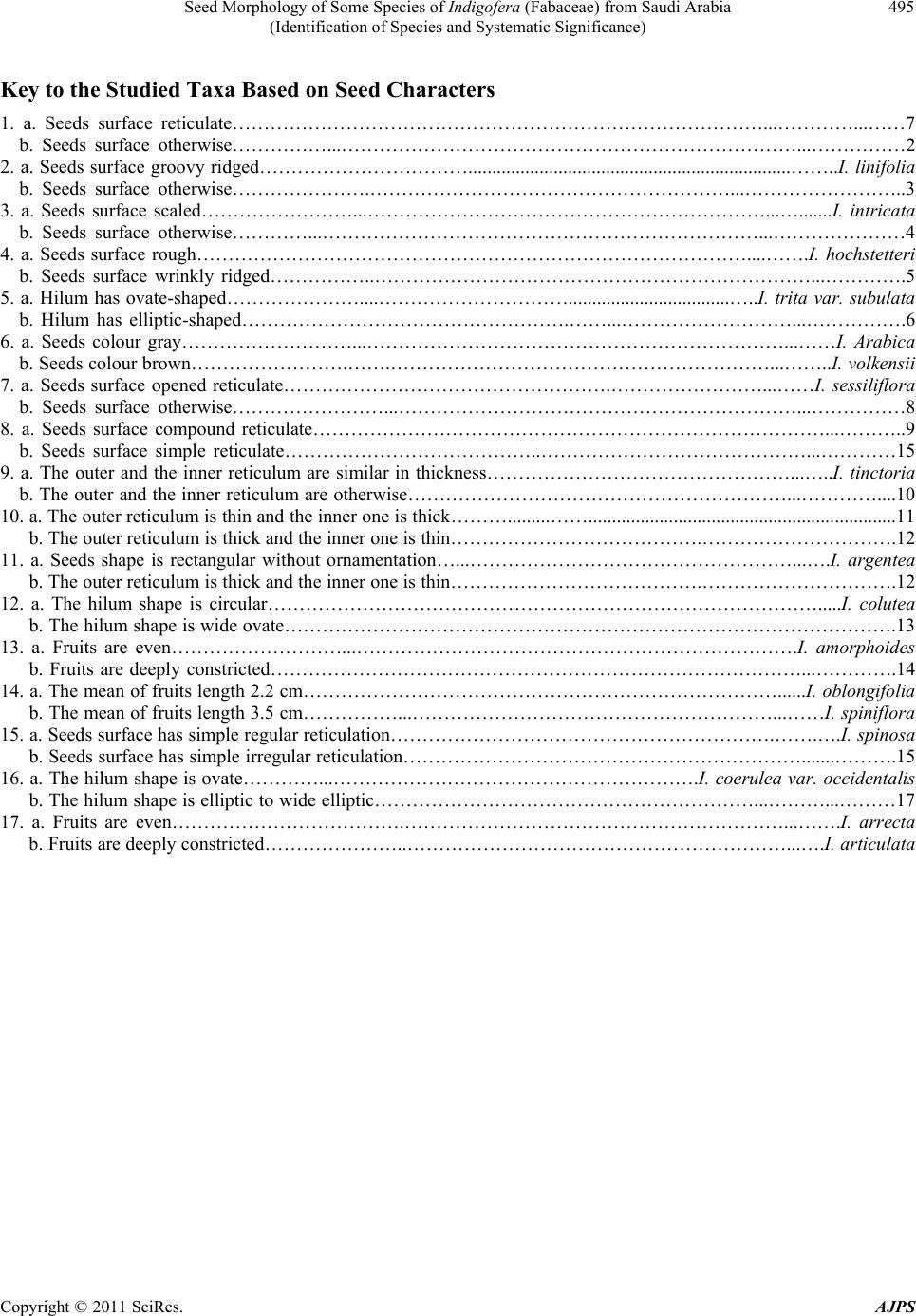 Seed Morphology of Some Species of Indigofera (Fabaceae) from Saudi Arabia 495 (Identification of Species and Systematic Significance) Key to the Studied Taxa Based on Seed Characters 1. a. Seeds surface reticulate…………………………………………………………………………...…………...……7 b. Seeds surface otherwise……………...………………………………………………………………...……………2 2. a. Seeds surface groovy ridged……………………………....................................................................……..I. linifolia b. Seeds surface otherwise………………….…………………………………………………...……………………..3 3. a. Seeds surface scaled……………………...………………………………………………………...….......I. intricata b. Seeds surface otherwise…………...……………………………………………………………...…………………4 4. a. Seeds surface rough……………………………………………………………………………....…….I. hochstetteri b. Seeds surface wrinkly ridged……………..……………………………………………………………...………….5 5. a. Hilum has ovate-shaped…………………....…………………………..................................…..I. trita var. subulata b. Hilum has elliptic-shaped…………………………………………….……...………………………...…………….6 6. a. Seeds colour gray………………………...…………………………………………………………...……I. Arabica b. Seeds colour brown…………………….…….……………………………………………………...……..I. volkensii 7. a. Seeds surface opened reticulate…………………………………………….……………………...……I. sessiliflora b. Seeds surface otherwise……………………...………………………………………………………...……………8 8. a. Seeds surface compound reticulate………………………………………………………………………...………..9 b. Seeds surface simple reticulate…………………………………..……………………………………...…………15 9. a. The outer and the inner reticulum are similar in thickness…………………………………………...…..I. tinctoria b. The outer and the inner reticulum are otherwise……………………………………………………...…………....10 10. a. The outer reticulum is thin and the inner one is thick……….........…….................................................................11 b. The outer reticulum is thick and the inner one is thin………………………………….………………………….12 11. a. Seeds shape is rectangular without ornamentation…...……………………………………………...….I. argentea b. The outer reticulum is thick and the inner one is thin………………………………….………………………….12 12. a. The hilum shape is circular…………………………………………………………………………….....I. colutea b. The hilum shape is wide ovate…………………………………………………………………………………….13 13. a. Fruits are even………………………...…………………………………………………………….I. amorphoides b. Fruits are deeply constricted…………………………………………………………………………...………….14 14. a. The mean of fruits length 2.2 cm…………………………………………………………………......I. oblongifolia b. The mean of fruits length 3.5 cm……………...…………………………………………………...……I. spiniflora 15. a. Seeds surface has simple regular reticulation…………………………………………………….…….….I. spinosa b. Seeds surface has simple irregular reticulation……………………………………………………….......……….15 16. a. The hilum shape is ovate…………...………………………………………………….I. coerulea var. occidentalis b. The hilum shape is elliptic to wide elliptic……………………………………………………...………...………17 17. a. Fruits are even……………………………….……………………………………………………...…….I. arrecta b. Fruits are deeply constricted…………………..……………………………………………………...….I. articulata Copyright © 2011 SciRes. AJPS |

